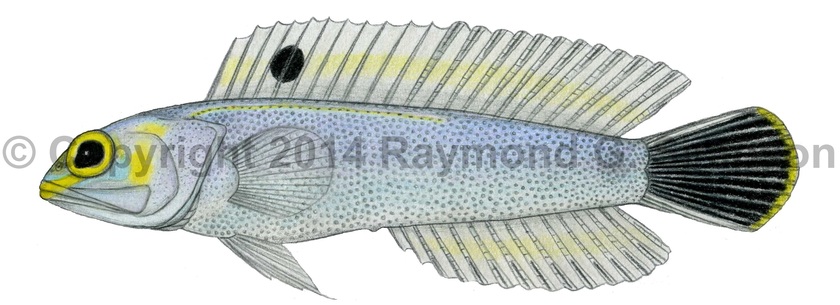
Common Name
Yellow Jawfish
Year Described
Böhlke, 1967
Identification
Dorsal Fin: XI, 12-14
Anal Fin: II, 12-14
Pelvic Fin: I, 5
Pectoral Fin: 17-19
Gill Rakers: 21-28 (lower limb of first arch)
Vertebrae: 10 precaudal, 18-19 caudal; 28-29 total
Maxilla of males without thin, flexible posterior extension. Jaws huge; reaching well past rear margin of orbit. Premaxillary and dentary with teeth. Vomer with 1-4 teeth. Lateral line extends posteriorly to between 2nd and 4th segmented dorsal ray. Nape, head, pectoral base, and area above lateral line scaleless. Rest of body fully scaled. Lateral scale rows: 72-95. Dorsal fin spines slender with sharp, flexible tips. Anterior nostril without a cirrus.
Color
Sexes are highly dimorphic. Males are lavender to blue-gray, becoming darker posteriorly. Lateral line surrounded by yellow. Head with a yellow stripe running from snout to eye. Eye yellow. Blue and yellow markings around rear of orbit. Fins pearly white to gray with a large dark blotch between spines 4 and 6 and a pale yellow median area. Caudal fin black with whitish margins. Female similar in body and head coloration but lacks the black blotches on the dorsal fin and tail. Median areas of dorsal, anal, and caudal fins yellow.
Size
Maximum size to 63mm SL.
Habitat
A moderately deepwater jawfish, collected in burrows between 25-45m.
Range
The Bahamas to the western Caribbean islands, off Honduras, to Jamaica and Puerto Rico.
References
Böhlke, J.E. 1967. A new sexually dimorphic jawfish (Opistognathus; Opistognathidae) from the Bahamas. Notulae Naturae (Philadelphia) No. 407: 1-12.
Böhlke, J.E. & C.C.G. Chaplin. 1993. Fishes of the Bahamas and adjacent tropical waters. 2nd edition. University of Texas Press, Austin.